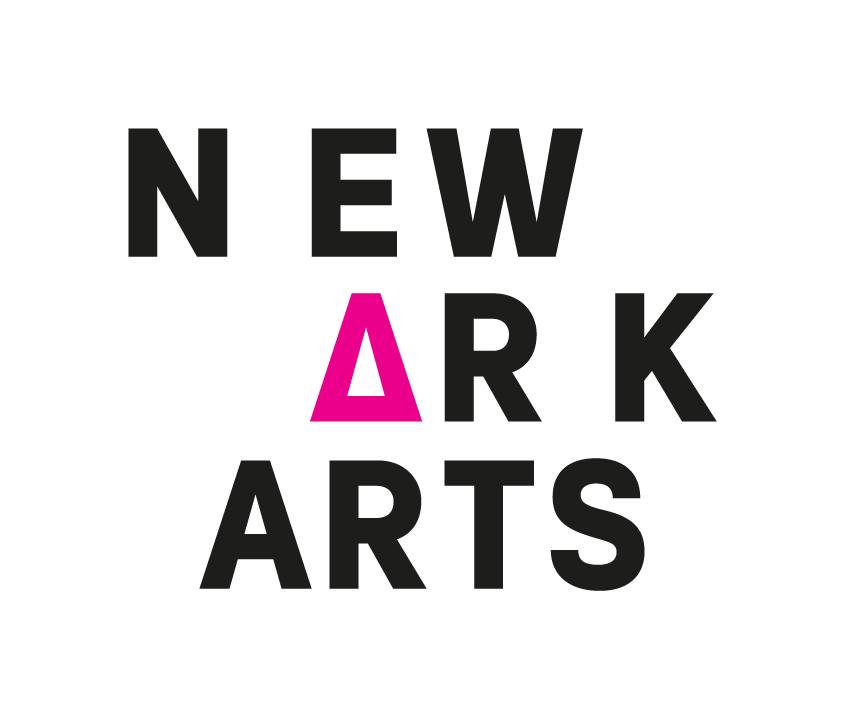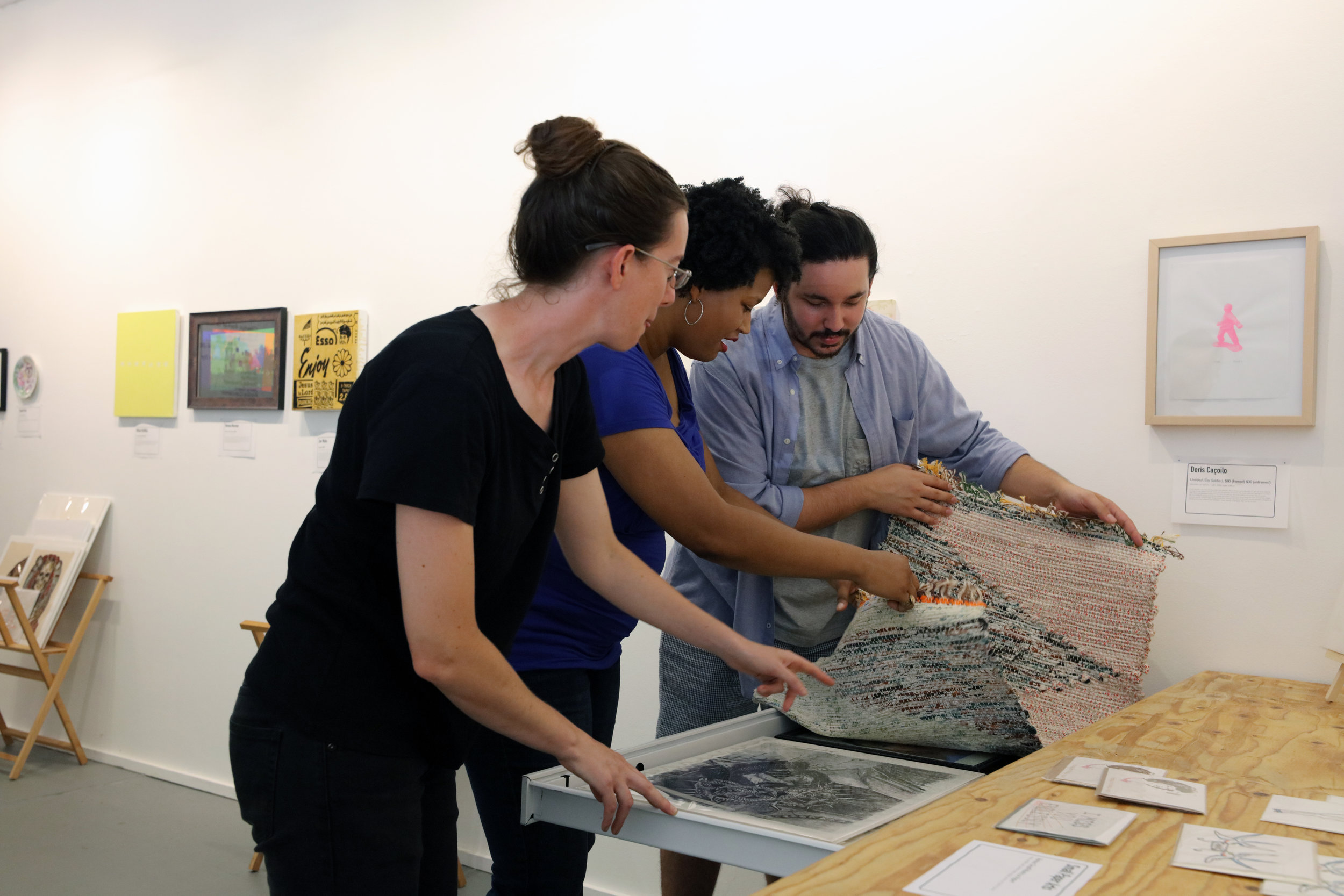GALLERY AFERRO
CO-FOUNDER EMMA WILCOX SPEAKS ABOUT DIY, BIG IDEAS & IMPACT
Co-Director Emma Wilcox, Gallery Manager Candace Nicholson, and Registrar Juno Zago | Photo Credit: Anthony Alvarez
WHAT WAS THE IMPETUS FOR STARTING GALLERY AFERRO?
A desire to play with ideas in public. The need to manifest, locate and share resources for artists, as artists. A shared wish to annihilate borders and barriers to cultural engagement. The possibly universal human need to shape one’s environment.
GALLERY AFERRO IS CELEBRATING ITS 15TH YEAR! IN WHAT WAYS HAVE YOUR PROGRAMS STAYED THE SAME AND IN WHAT KEY WAYS HAVE THEY EVOLVED?
Our programs will always evolve as we assume the form that seems to be required and share the power of shaping that form. Art always institutionalizes itself, so one has to be ready to resist the mandate to stick with a formula. Interestingly, though, I think it can be radical to be consistent in some ways, to steward something and become trustworthy in a community. DIY begins as necessity but it also is a way of understanding and being in the world. Some of the things we do include exhibits and an extremely wide range of events, an artist workspace residency program, educational programs, publications, public art, permanent sound installations, a community book room, and many hybridized projects that defy description…but I know that we will always be doing new things. Aferro was originally conceived as being nomadic. So it felt good to take a really ambitious project, Aferro Mobile Portrait Studio on the road 2016-2017 to celebrate Newark’s 350th year. The project was a synthesis of our earliest ideas, and what we learned being in a community for a long time. The original goal was to create free portraits of 350 Newarkers, using a fully equipped professional photo studio run off a generator out of a cargo trailer. But by late summer of 2016, we had photographed 1000 or so people, didn’t have the desire to stop, and it seemed like people didn’t want us to. One of the project parameters was that we went (BBQs, flea markets, concerts, warehouse parties, outside church…) only where we were invited. So there isn’t a conventional project timeline; you often don’t know where you are going next. It’s generative, and it’s an exercise in relinquishing and sharing control, making it an actual exchange.
WHAT DO YOU FORESEE FOR YOUR NEXT 15 YEARS?
Gallery Aferro is, beyond anything else, beyond the details of any particular program, the manifestation of a daily practice of love, a kind of stubborn love wherein a group of ordinary people claim some physical and intellectual territory and hold it as far apart as we can, with constant effort, from the forces of extractive capitalism, and from the forces of repression and backlash that rise up over and over again in American history.
Our programs will always evolve as we assume the form that seems to be required and share the power of shaping that form. Art always institutionalizes itself, so one has to be ready to resist the mandate to stick with a formula. Interestingly, though, I think it can be radical to be consistent in some ways, to steward something and become trustworthy in a community. DIY begins as necessity but it also is a way of understanding and being in the world. Some of the things we do include exhibits and an extremely wide range of events, an artist workspace residency program, educational programs, publications, public art, permanent sound installations, a community book room, and many hybridized projects that defy description…but I know that we will always be doing new things. Aferro was originally conceived as being nomadic. So it felt good to take a really ambitious project, Aferro Mobile Portrait Studio on the road 2016-2017 to celebrate Newark’s 350th year. The project was a synthesis of our earliest ideas, and what we learned being in a community for a long time. The original goal was to create free portraits of 350 Newarkers, using a fully equipped professional photo studio run off a generator out of a cargo trailer. But by late summer of 2016, we had photographed 1000 or so people, didn’t have the desire to stop, and it seemed like people didn’t want us to. One of the project parameters was that we went (BBQs, flea markets, concerts, warehouse parties, outside church…) only where we were invited. So there isn’t a conventional project timeline; you often don’t know where you are going next. It’s generative, and it’s an exercise in relinquishing and sharing control, making it an actual exchange.
YOU HAVE PROVIDED RESIDENCY AND EXHIBITION OPPORTUNITIES FOR LGBTQIA ARTISTS IN THE PAST. AS SPACES ARE GRADUALLY BECOMING MODERATELY LESS HOSTILE, HOW DO YOU SEE YOUR ROLE IN PROVIDING THESE OPPORTUNITIES CHANGING?
I don’t really experience it as a state of “moderately less hostile,” for me it is less a linear progression and instead something more complicated. I am thinking of the spontaneous vigil that Aljira, a Center for Contemporary Art, and Gallery Aferro held the day after the Pulse shooting, and also of when the gallery was the only NJ space to participate in the nationwide protest screenings organized in the wake of the censoring of “Fire in My Belly” by David Wojnarowicz from the National Portrait Gallery. The art and writing of people like David, and Reinaldo Arenas, both of whom died of AIDS in the early 90’s, whom we never met, are from a different time, but give us strength every day for right now. But more than anything, I am thinking of the queer or nonconforming or questioning youth who intentionally seek out and engage with the gallery. It is so important to be that space for someone. For all of us, the need for intergenerational dialogue and exchange between queer people of varying ages is real. The way language is used can be different. The distance between the lived experiences of those generations can seem to expand and contract in a given day; and being a space for dialogue is something that I am proud of about Gallery Aferro’s ongoing work.
REFLECT ON THE LANDSCAPE OF THE NEWARK ARTS SCENE IN THE EARLY 2000S.
In my entirely subjective memory it was a somewhat more intimate social landscape. The “by us, for us” ethos was potent, and I have many memories of extraordinary beautiful architecture activated by artists and others. The “Open Doors” in Open Doors were artists opening their generally grey-zone, commercially-zoned live/work spaces to the public. That is an important aspect of our history to remember, consider, and learn from. What audience are we imagining? For whom do we do our work? What spaces and resources are accessible to youth, and to working-class people? As of late, the people described locally as “visionary leaders” in press releases tend to be C-suite type folks, generally male, but when I think of a leader I see many different people, of varying genders, temperaments, and 1040 tax filings.
Jared Ash, former Special Collections Curator and Librarian at the Newark Public Library, currently with the Metropolitan Museum’s Watson Library, and overall cultural stewardship hero, brought to my attention as well how the transition from print to online during that time impacted what we now have as a narrative. I’ve noticed that when artists in almost any community get together, especially elders, there is this litany, this recitation of names, of artists, culture workers, and spaces, a hex against erasure. Newark has a long cultural history, so there are many names. It is deeply meaningful to me that we still work regularly with most of the first dozen people we met when we came here. I will never forget the time that Bill May, who was then Director of Visual and Performing Arts for the Newark Public Schools, organized an entire squadron of school buses carrying dozens and dozens of teachers to come visit the first Aferro, which was in a loft.
WHAT ARE THREE OF YOUR FAVORITE PAST PROJECTS?
Too many to even get into here! Broadly speaking, I love when people stop me and tell me about their memories and impressions of something I had a hand in launching or hosting. Sometimes it takes me a few minutes to figure out what they are describing, when it’s an intense and specific memory, such as seeing the neon, kinetic sculptures, and videos of our public art project, Activate: Market Street, from the night bus after a long shift. The best projects bring people together in memorably unusual contexts. And my memories of Aferro are in 24 hour time, and include the 48 Hour Line, in 2007, two straight days and nights of continuous uninterrupted drawing by hundreds of people, or one of times we did something we called Market Street Convergence, which involved 22 different exhibitions across 4 buildings on one block, all in one night. Some of the conversation that happened as part of Gladys Barker Grauer’s 2017 solo exhibit was extraordinary, as she connected the present moment to the radical world of the Depression as part of what shaped her.
WHAT IS YOUR WISH FOR AFERRO IN THE FUTURE?
Nothing less than the word Aferro being a noun, a verb, a sound, integrated into conversation about authentic and memorable experiences and what people are proud of in their community. Not a thing less than that.

